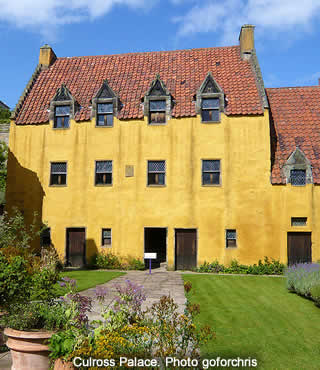Culross |
|
 |
|||
A living memorial to 17th century industrial Scotland |
||||
|
||||
As the story goes: when an ancient British princess fell pregnant before marriage, her enraged parents threw her from a cliff. She survived, thanks to a chance encounter with an unmanned boat. She sailed across the water to the then-tiny town of Culross, and started a new life there. |
||||
This tale may be no more than a myth, but there's no doubting Culross' more recent history. In the 16th and 17th centuries it became home to such important industries as coal mining and salt panning. |
||||
The biggest businessman in town was Sir George Bruce, builder of the first ever coal mine to extend under the sea. This was so unbelievable at the time that even James I came to visit. The King was unnerved by the whole experience, and for a moment he thought it was all just a cunning assassination attempt. |
||||
Sir George's achievement earned him more money than he knew what to do with. He spent a good chunk of it on Culross Palace, a lavish building which became the Bruce family home. The architects used expensive materials from all over the world, like Baltic pine and Dutch glass. The interior was decorated with detailed murals and ceiling paintings. Nevertheless, the word "palace" might be a little boastful. It's more like a mansion; a home for the area's greatest merchant. |
||||
To find the place, look out for its bright yellow walls. Beneath them are rows of herbs and vegetables, growing in the reconstructed 17th century garden. This fresh produce is available to buy, if you come at the right time of year. |
||||
Just outside the palace is a memorial to Thomas Cochrane, a local hero and one of Scotland's greatest ever Naval officers. During his eventful life he won impossible victories against European fleets, became an MP, eloped with a girl 20 years his junior, was falsely convicted of fraud, and was knighted. Somehow he also found time get involved with the mines, here in his home town. Cochrane's changes included the banning of women and girls from working underground. |
||||
Within a stone's throw of this memorial is the Town House. It had many functions in its day, including administration, and the imprisonment of witches. The council rooms now hold public exhibitions throughout the year. They're on the first floor, with wonderful views over the Firth of Forth estuary. |
||||
Watching the village from a high hill are the ruins of its 13th-century abbey. A display board shows the original floor plan, but it changed so much over the years that the current layout doesn't really match up. Despite its age, enough of the walls, vaults and arches are still standing for you to get a good impression of how impressive the abbey used to be. The church building is still open; this is where Sir George Bruce and his family were buried. They have their own vault, with detailed carvings above their final resting place. |
||||
Culross' 16th century atmosphere isn't just represented by its main buildings, but by all the smaller ones too. The National Trust for Scotland have been hard at work here for over 70 years! It has become an accurate portrait of what such a village might really have looked like, 5 full centuries in the past. |
||||
|
Pocket Britain is optimised for use on a smartphone or tablet with internet access. All content is subject to copyright. All reasonable methods have been used to ensure information supplied is accurate at the time of publication. However, it is advisable to check information before relying on it. Privacy Policy |